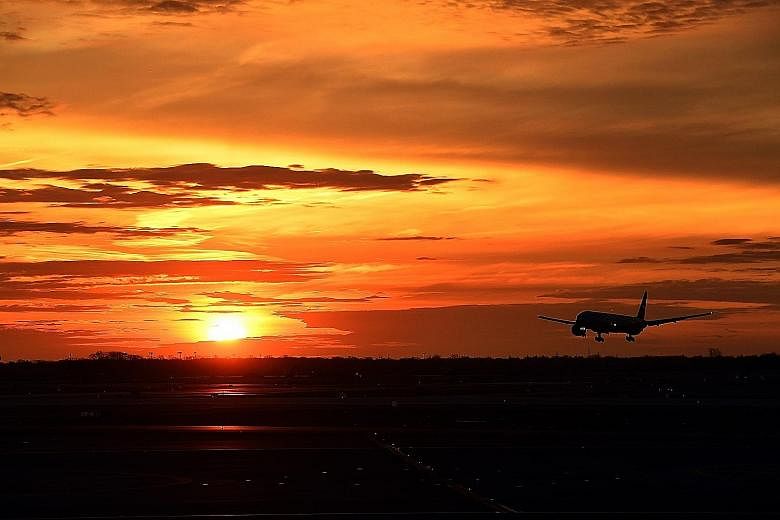HONG KONG • An unprecedented boom in the US$280 billion (S$385 billion) aircraft finance industry is showing signs of faltering as rising interest rates, cut-rate competition and higher oil prices trigger a shake-out in a sector that has attracted a flood of Chinese funding.
Conferences in Hong Kong last week saw over 1,000 financiers, lawyers and airline bosses talk up the fundamentals of an industry that has emerged as a flourishing asset class globally, but in contrast to previous years, the mood was one of subdued optimism even as corks popped on new deals.
Concerns about central bank tightening, trade rows and currency swings could blow some froth, they cautioned.
"I think the party is over in terms of lower interest rates," said Mr Robert Martin, chief executive officer of Asia's largest-listed aircraft lessor BOC Aviation.
The sector veteran of three decades noted that smaller players who had not matched their funding needs to liabilities, unlike larger ones like his company, would find it difficult to ride out any volatility.
The failure to do so has caused some high-profile collapses, such as Guinness Peat Aviation (GPA) in the 1990s.
The former GPA executives who now dominate the industry say the sector has matured and is backed by diversified sources of funding as aviation finance sits proudly alongside property and infrastructure as alternatives to traditional market bets.
Yet danger signals have emerged, such as a stronger dollar hitting the coffers of many airlines just as they must adjust to a spike in oil prices.
That could land unwanted aircraft back into the laps of lessors needing to find new takers.
In a sign of turbulence ahead, global airlines have already slashed profit forecasts due to high oil prices.
A few leasing companies are also quietly giving airlines rental "holidays" to help their cash flows, sources said.
And some airlines are increasing traffic only by cutting prices, which will hurt all but those with the lowest costs, said Mr Rob Morris, chief consultant at Flight Ascend.
According to Mr Stuart Hatcher, chief operating officer of asset managers IBA: "The market is poised for the start of a correction. There are too many signals."
The industry, however, remains in better shape than in previous cycles, driven by consolidation in the United States.
Airlines have begun to recoup their costs of capital in the past four years after decades of value destruction, according to the International Air Transport Association.
Demand for financing for new commercial aircraft deliveries is expected to rise almost 7 per cent this year to US$139 billion, Boeing has said.
Last week, financiers were busy doing deals overlooking Hong Kong's Victoria Harbour at conferences hosted by Airline Economics and Euromoney's Airfinance Journal.
Lessors say liquidity is abundant and that financial strains in one part of the globe can be offset by demand elsewhere.
Currently, Chinese capital accounts for about 30 per cent of the funding deployed by leasing firms worldwide, up from 5 per cent about nine years ago.
But while the carousel continues, the flood of new money chasing deals has lowered returns for most in the industry.
Goshawk Aviation, a venture of Hong Kong conglomerate NWS Holdings and Chow Tai Fook Enterprises, says the sector's low yields are not feasible for long.
Mr Brian Cheng, executive director at NWS that bought Dublin-based Sky Aviation Leasing this year, said he had seen funding bids from firms prepared to accept returns of 3-5 per cent on their aircraft investments. "Insurance companies or banks can achieve (these rates) because their borrowing costs are so low... but for us, there's no way to compete with that."
Against that backdrop, opportunistic mergers and acquisitions are also picking up.
Japan's Orix Corp struck a US$2.2 billion deal this year for a 30 per cent stake in leasing firm Avolon Holdings. SMBC Aviation Capital, Sumitomo Mitsui Banking's leasing arm, expects to receive an extra US$1 billion from shareholders in a couple of months, Mr Peter Barrett, CEO of the world's No. 5 lessor said.
But with air pockets in sight, industry executives point to an expected shake-out among smaller lessors. Some smaller Chinese players are already pulling back.
Said Mr Cheng: "It's like driving a car on the expressway. Everybody is on the gas pedal right now. No one is going to the gas station or taking a break. Everybody is full throttle but something has got to give. Some cars will just head off to the exit."
REUTERS

